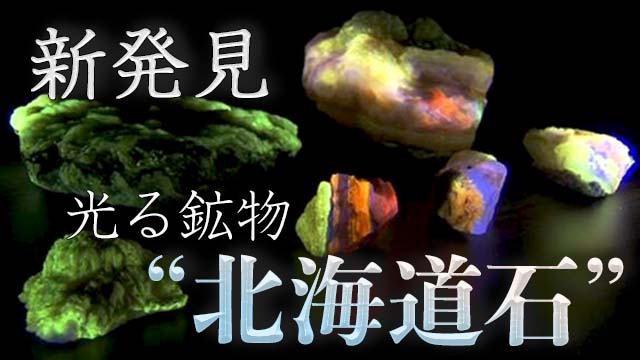A new mineral that glows vividly when exposed to ultraviolet rays was found in Hokkaido and was registered as "Hokkaido stone" by an international organization. It is presumed that the remains of organisms in the strata were formed by the geothermal heat of volcanoes, which may lead to the elucidation of the mechanism by which oil is formed.
The newly discovered "Hokkaido stone" is a type of "organic mineral" made of elements possessed by living organisms such as carbon and hydrogen, and is pale yellow in natural light, but is characterized by emitting bright yellow and yellow-green fluorescence when exposed to ultraviolet rays.
The scientific name is "hokkaidoite" and it was registered with an international organization in January this year.
It was included in opal, a type of gem obtained by research groups such as the Sagami Central Chemical Laboratory and Osaka University, in the mountain forests of Shikaoi Town, Hokkaido, as well as in rocks found by amateur mineralogists in Aibetsu, Hokkaido.
A detailed analysis by the research group revealed that it is a new type of mineral composed of a substance called benzoperylene, which is contained in very small amounts in petroleum and other substances, and was registered with an international organization in January as "Hokkaido stone" or scientific name "hokkaidoite".
"Hokkaido stone" is presumed to have been formed by the geothermal heat of volcanoes by the remains of organisms in the strata, which may lead to the elucidation of the mysterious mechanism of oil production.
Ryoji Tanaka, a senior researcher at the Sagami Central Chemical Research Institute, said, "We applied for a large name for Hokkaido because it was a pretty beautiful and eye-catching mineral from two places in Hokkaido Japan.
The detailed production area of "Hokkaido stone" is not disclosed for protection, but the actual stone will be exhibited at the "Tokachi Shikaoi Geopark Visitor Center" in Shikaoi Town from the 1th of this month.
Improving the performance of analyzers leads to the discovery of about 100 types of minerals around the world every year
According to the research group, in order to register a new mineral, a committee of the International Mineralogical Union, an international organization, discusses the status of the mineral as an independent species and the legitimacy of the name, and it is approved and registered with a two-thirds majority.
In recent years, the performance of the analyzer has improved, and about 3 kinds of minerals are found every year, and one to two types are registered in Japan.
Background and significance of the discovery of "Hokkaido stone"
The discovery of this "Hokkaido stone" was triggered by the fact that an amateur mineralogist provided a specimen of a stone collected from an old mine in Aibetsu Town, Hokkaido in January last year, and it contained an unfamiliar mineral about 1 mm in yellowish color.
The research group analyzed this mineral because it fluoresces when exposed to ultraviolet light, and upon closer examination, they realized that there was another mineral that fluoresces in the same way nearby, although there have already been cases of discovery overseas.
This mineral was considered a new species, but the amount was small enough to obtain sufficient analytical data, so the research group investigated whether there were other production areas and focused on information that there was a natural opal in Shikaoi Town, south of Aibetsu Town, that fluoresces when exposed to ultraviolet rays on the mountainside.
In June last year, the research group obtained permission to collect samples and proceed with analysis.
As a result, the same mineral as that of Aibetsu Town was found, and after detailed analysis, it was found that it was a new type of mineral composed of an organic compound composed of carbon and hydrogen called "benzoperylene", which is contained in a very small amount in petroleum, etc., and we applied to the International Mineralogical Union.
The existence of fluorescent opals has been known in Shikaoi for about 3 years, but this research has revealed that the glow of opals is due to minerals that have fluorescent characteristics, such as "Hokkaido stone".
According to the group, most of the minerals are "inorganic minerals" such as diamonds, and it is extremely rare to find "organic minerals" made of compounds composed of elements that living organisms have, such as carbon and hydrogen.
"Hokkaido stone" is thought to have been formed by the geothermal heat of volcanoes on the remains of organisms in the strata, and is similar to the process by which the remains of underground organisms are altered by high pressure and temperature to form petroleum.
Research Group "Leads to clues to elucidate the mechanism of oil production"
Ryoji Tanaka, a senior researcher at the Sagami Central Chemical Research Institute of the research group, said, "The mechanism by which petroleum is produced has not been clearly elucidated, but we believe that investigating the mechanism by which 'Hokkaido stone' is formed will lead to some clues."

